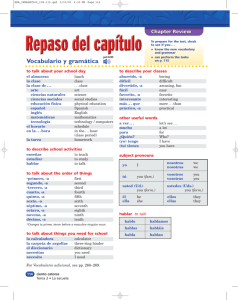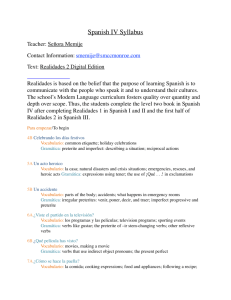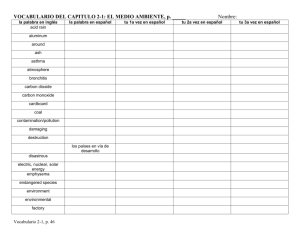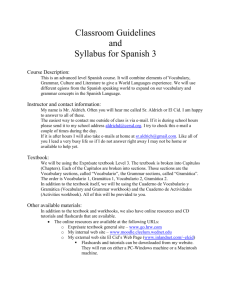Spanish IV Honors - Northgate High School World Languages
advertisement
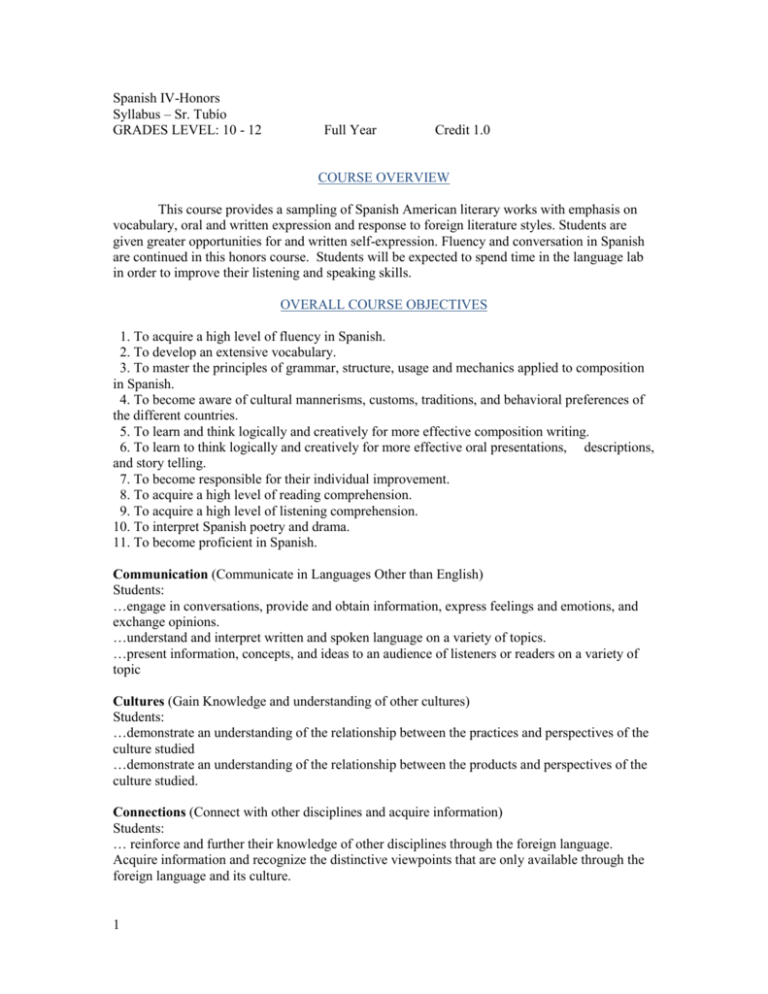
Spanish IV-Honors Syllabus – Sr. Tubío GRADES LEVEL: 10 - 12 Full Year Credit 1.0 COURSE OVERVIEW This course provides a sampling of Spanish American literary works with emphasis on vocabulary, oral and written expression and response to foreign literature styles. Students are given greater opportunities for and written self-expression. Fluency and conversation in Spanish are continued in this honors course. Students will be expected to spend time in the language lab in order to improve their listening and speaking skills. OVERALL COURSE OBJECTIVES 1. To acquire a high level of fluency in Spanish. 2. To develop an extensive vocabulary. 3. To master the principles of grammar, structure, usage and mechanics applied to composition in Spanish. 4. To become aware of cultural mannerisms, customs, traditions, and behavioral preferences of the different countries. 5. To learn and think logically and creatively for more effective composition writing. 6. To learn to think logically and creatively for more effective oral presentations, descriptions, and story telling. 7. To become responsible for their individual improvement. 8. To acquire a high level of reading comprehension. 9. To acquire a high level of listening comprehension. 10. To interpret Spanish poetry and drama. 11. To become proficient in Spanish. Communication (Communicate in Languages Other than English) Students: …engage in conversations, provide and obtain information, express feelings and emotions, and exchange opinions. …understand and interpret written and spoken language on a variety of topics. …present information, concepts, and ideas to an audience of listeners or readers on a variety of topic Cultures (Gain Knowledge and understanding of other cultures) Students: …demonstrate an understanding of the relationship between the practices and perspectives of the culture studied …demonstrate an understanding of the relationship between the products and perspectives of the culture studied. Connections (Connect with other disciplines and acquire information) Students: … reinforce and further their knowledge of other disciplines through the foreign language. Acquire information and recognize the distinctive viewpoints that are only available through the foreign language and its culture. 1 Comparisons (Develop insight into the nature of language and culture) Students: … demonstrate understanding of the nature of language through comparisons of the language studied and their own … demonstrate understanding of the concept of culture through comparisons of the cultures studied and their own. Communities (Participate in Multilingual Communities at home and around the world) … use the language both within and beyond the school setting. … show evidence of becoming life-long learners by using the language for personal enjoyment and enrichment. METHODS OF INSTRUCTION - Textbook and workbook (daily written and oral activities) Lectures (Notes on Smartboard and PowerPoint presentations) Conjugation and vocabulary Drills Tests and Alternate assessment Reading: Pre-reading activities, readings, strategies, activities while you read and after you read Communication: Vocabulary in context, Activities for vocabulary and grammar building Culture: Cultural readings. Writing: activities in Orthography and the Writer’s Workshop (written assignments) Listening and Speaking: Recorded audio performances of selected readings from each collection; one listening or reading activity that goes with each corresponding “Vocabulario” and “Gramática” sections; each “Ortografía” ends with a comprehensive dictation activity; a recording of each Cultura y comparaciones presentations is provided to build on students’ listening skills Mayor Assessments: The structure of the Assessment Program, NUEVAS VISTAS curso de introducción is as follows: Literature Quizzes: The quizzes test basic reading comprehension, analytical and composition skills, and students’ understanding of the “Elementos de literatura” sections in the Pupil’s Edition. Language Quizzes: There are grammar and vocabulary quizzes per collection, focusing principally on writing and reading skills and featuring more discrete, closed-ended assessment. All these quizzes may be used for evaluation, or for review in preparation for collection tests. Culture Quizzes: There is one quiz for each Cultura y lengua section of the six collections in the Pupil’s Edition. Collection Tests: There are two tests per collection, one for reading and one for language. Only the language test will be administered. Alternative Assessment: There will be a variety of activities for assessing written and verbal communication at the end of each collection. 2 Performance Assessment: This section provides an alternative to traditional testing methods by using authentic situations as contexts for performing communicative, competency-based tasks. For every collection of the Pupil’s Edition, there are four performance assessment suggestions. These suggestions give students the opportunity to demonstrate both acquired language proficiency and cultural competence in interviews, conversations, dialogues, or skits. These activities can be performed for the entire class or they can be recorded for evaluation at a later time. These activities provide additional practice for the oral section of the Advanced Placement Spanish Language Exam, which most of the students in Spanish 4 Honors will be taking the following year All these components will be used as evaluation for each “Colección” TEXTBOOKS Textbook: Advanced Spanish – NUEVAS VISTAS curso de introducción, Holt, Rinehart and Winston, 2003 Workbook: Cuaderno de práctica – NUEVAS VISTAS curso de introducción OTHER MATERIALS (Example: film, audio tapes, etc.) Media Program Audio program: The Nuevas Vistas Curso de introduccion Audio Program: Recorded audio performances of selected readings from each Colección which can be placed to enhance students’ experience of the Pupil’s Edition presentation. Audio and visual resources from CNN en español, El Sentinel en español (local newspaper) and many other on line Foreign Language Newspapers, videos etc. Sanako Language Laboratory – a state of the art, fully digital Language Laboratory GRADING POLICY THE CLASS WILL BE CONDUCTED IN SPANISH!!!!!!!! GRADES – Your grade for each quarter will be determined by the following percentages: TESTS/QUIZZES/PROJECTS AND FORMAL WRITING- 64% DAILY WORK – 8% (homework, class participation, class worksheets and activities) HOMEWORK.- 8% FINAL.- 20% Tests will be given frequently on grammar, culture and vocabulary. There will be a number of quizzes, both written and oral. All tests and quizzes will be announced ahead of time. Being absent the day before an announced test or quiz does not excuse you from taking it on the announced day. As per our School Wide Late Work and Make-Up Policy in the student handbook, “Students must hand work in on time for credit. No late work will be accepted”. IT IS YOUR RESPONSIBILITY to find out from the teacher what work you need to make-up (quizzes, tests, homework assignments etc.). Check at www.tubio.org or your teacher’s website for the assignments. 3 One mayor writing assignment will be assigned for each chapter. CLASSROOM BEHAVIOR Arriving to class after the bell, eating or talking during the class will not be tolerated. Textbooks, workbooks, notebooks, paper, pencil and pens (black and blue) are to be brought to class on a daily basis. You are not to borrow any materials from your classmates; it disturbs the other members of the class when you are not prepared. Pacing Calendar 2014-2015 Northgate High School Spanish IV 2014 S M T W T F S MAY S M T W T F S JUNE S M T W T F S JULY S M 25 SEPTEMBER OCTOBER NOVEMBER 7 14 21 28 1 8 15 22 29 2 9 16 23 30 3 10 17 24 4 11 18 25 5 12 19 26 6 13 20 27 5 12 19 26 6 13 20 27 7 14 21 28 1 8 15 22 29 S M T W T F S S M T W 2 9 16 23 30 3 10 17 24 31 4 11 18 25 T F S 2 9 16 23 30 T W T F S 26 27 28 29 30 AUGUST DECEMBER 3 10 17 24 4 11 18 25 5 12 19 26 6 13 20 27 7 14 21 28 1 8 15 22 29 M T W T F S 7 14 21 28 1 8 15 22 29 2 9 16 23 30 3 10 17 24 31 4 11 18 25 5 12 19 26 6 13 20 27 S M T W T F S 7 14 21 28 1 8 15 22 29 2 9 16 23 30 3 10 17 24 4 11 18 25 2015 JANUARY 4 11 18 25 5 12 19 26 FEBRUARY 6 13 20 27 7 14 21 28 1 8 15 22 29 2 9 16 23 30 3 10 17 24 31 7 14 21 28 1 8 15 22 29 2 9 16 23 30 MAY 3 10 17 24 31 1 8 15 22 2 9 16 23 3 10 17 24 4 11 18 25 5 12 19 26 6 13 20 27 7 14 21 28 JUNE 4 11 18 25 5 12 19 26 6 13 20 27 Non teaching days Finals 4 7 S MARCH 1 8 15 22 29 2 9 16 23 30 JULY 1 8 2 9 3 10 4 11 5 6 APRIL 3 10 17 24 31 4 11 18 25 5 12 19 26 6 13 20 27 7 14 21 28 5 12 19 26 6 13 20 27 AUGUST Colección 1: “”Así somos” (08/25-10/03) (The selections in this collection center on the themes of personalities and hobbies.) Reading Antes de Leer provides students with vocabulary support and two pre-reading strategies: compare and contrast, and impressions of a text; which will build students’ comprehension and confidence in reading the selections. Lecturas: “Yo soy, tú eres, él es …” y “Viajes” de Julio Cortázar Estrategias: Comparing and contrasting; impressions about the text – these strategies will help students understand important details and relationships in the text, as well as practice predicting the contents of a reading selection based on important vocabulary words Después de leer – students are provided with oral and written activities that further their comprehension of the selections and reinforce the ideas presented herein. Communication Vocabulario en contexto – This section offers students the opportunity to practice vocabulary in the context of the readings. Mejora tu vocabulario - synonyms and antonyms Students learn and practice the use of synonyms and antonyms, enriching their active and passive vocabulary. Gramática: The indicative; mood; “ser”, “estar” and “gustar”; adjectives; the present progressive; the present perfect; comparatives Culture Notas culturales Una leyenda colombiana; los medios de comunicación en los países hispanohablantes Cultura y comparaciones Ritmo y foclor del mundo hispano – a brief overview of some traditional dances in the Spanishspeaking World and their origins. Writing Ortografía – Students review proper spelling guidelines and are given the opportunity to practice these common sources of confusion in Spanish. Acentuación: the tonic accent Letra y sonido: the letter h; the /y/ sound 5 Taller del escritor: Informal and formal correspondence; these workshops prepare students for formal and informal correspondence in Spanish, introducing them to common formats and formulas for letters and encouraging them to practice these. Así se dice: Letter writing: opening, body, closing; formal openings and closings Repaso – is a checklist that students can use on their own to see if they have achieved the goals stated at the beginning of the “Colección” Language Lab: Tell a story - Picture sequence #93 – Cuenta la historia que se desarrolla en los dibujos. Colección 2: La niñez (10/06-11/17) (The selections in this collection center on the theme of childhood.) Reading Antes de Leer – provides students with vocabulary support in the form of “Mi pequeño diccionario”, an easy-to-use glossary prior to each reading. Here students practice words from the “Vocabulario en contexto” activities before they come across them in the actual reading. Prereading strategies in this section, thinking aloud and making deductions Lecturas: Carmen Kurtz “El nacimiento” de Veva Elena Poniatowska “Los juegos de Lilas” de Lilus Kikus Estrategias: Thinking aloud; making deductions Mientras Lees – This section helps students better understand what they read. Each “Estrategia and Mientras lees” section helps them tap into their critical-thinking abilities so they become more disciplined and thoughtful readers. Después de leer – Comprehension questions at the end of each reading selection Communication Vocabulario en contexto Mejora tu vocabulario Contextual clues; lexical register Gramática: Past indicative: the preterite and the imperfect; nominal pronouns; indirect and direct object pronouns; the preterite and imperfect in context; the past continuous; the past perfect Culture 6 Notas culturales: Los Reyes Magos; la familia Cultura y comparaciones Datos históricos del mundo hispano Writing Ortografía Acentuación: written accents: “palabras agudas y llanas” Letra y sonido: the letters (b) and (v); the letters (m) and (n) Taller del escritor: A biographical sketch; an autobiographical episode Así se dice: Writing about someone’s life; making a description Repaso Language Lab: Tell a story - Picture sequence #123 – Cuenta la historia que se desarrolla en los dibujos Colección 3: El mundo en que vivimos (11/18-01/13) (The selections in this collection center on the world we live in today. The main focuses of this collection are two main aspects of the world we live in today – technology and the environment.) Reading Antes de Leer Lecturas: “Tecnología: Rumbo al futuro” “Protejamos nuestra Tierra” Estrategias: Graphic clues; chain reactions Mientras Lees Después de leer Communication Vocabulario en contexto Mejora tu vocabulario: Neologisms; cognates and false cognates Gramática: The future; the future perfect; the conditional; reflexive verbs; the imperative mood; simultaneous use of direct and indirect object pronouns; simple and complex sentences Culture Notas culturales La tecnología a través de los idiomas; el diluvio universal 7 Cultura y comparaciones Diversidad geográfica del mundo hispano Writing Ortografía Acentuacion: diphthong and hiatus Letra y sonido: the /s/ sound Taller del escritor: An advertisement; an exposition Así se dice: Writing an advertisement; talking about cause and effect Language Lab: Tell a story - Picture sequence #153 – Cuenta la historia que se desarrolla en los dibujos Repaso for the Final (01/14-01/20) Second Semester Colección 4: El misterio y la fantasía (01/27-03/10) (The reading selections in this collection center on the theme of mystery and fantasy.) Reading Antes de Leer Lecturas: Guillermo Samperio “Tiempo libre” Carlos Fuentes “Chac Mool” Estrategias: The most important word; anticipating Mientras Lees Después de leer Communication Vocabulario en contexto Mejora tu vocabulario: Word families ; Word formation Gramática: The subjunctive: use and conjugation of the present subjunctive; the subjunctive in noun clauses; expressions of influence and emotion; expressions of doubt and impersonal judgements; the present perfect subjunctive; the subjunctive in adjectival clauses; prepositions; adverbs 8 Culture Notas culturales: El fútbol; Chac Mool ¡Mira, tienes una carta! Al mundo le hace falta más romance Cultura y comparaciones: Arquitectura del mundo hispano Writing Ortografía Acentuación: written accents; palabras esdrújulas and sobreesdrújulas Letra y sonido: the /k/ sound (c, qu, k) Taller del escritor: Fantasy; an informative article Así se dice: Expressing surprise; presenting information Repaso Language Lab: Tell a story - Picture sequence #183 – Cuenta la historia que se desarrolla en los dibujos Colección 5: El amor (03/11-04/29) The selections in this collection center on the theme of love. Reading Antes de Leer Lecturas: Laura Esquivel “Enero: tortas de Navidad” de Como agua para chocolate Horacio Quiroga: “El hijo” Estrategias: Tea party; read, evaluate and reread Communication Vocabulario en contexto Mejora tu vocabulario More prefixes; more suffixes Gramática: Adverbial clauses: the indicative and the subjunctive in adverbial clauses; relative clauses; the imperfect subjunctive in noun, adjectival and adverbial clauses; conditional sentences and the imperfect subjunctive 9 Culture Notas culturales: El realismo mágico; nuevas autoras hispanas; el tupí-guaraní Cultura y comparaciones:Sabor culinario del mundo hispano Writing Ortografía Acentuación: the diacritical accent Letra y sonido: the /x/ sound Taller del escritor: A persuasive essay; a script Así se dice: Persuading or convincing; writing a script Repaso Language Lab: Tell a story - Picture sequence #213 – Cuenta la historia que se desarrolla en los dibujos Writing activity: Carta de amor/poema. Colección 6: El poder de la palabra (04/30-06/04) The texts selected for reading and analysis in this collection center on the theme of writing. Reading Antes de Leer Lecturas: Miguel de Cervantes de Don Quijote de la Mancha Estrategias: Contrasting; context clues Mientras Lees Después de leer Communication Vocabulario en contexto Mejora tu vocabulario Figurative language; metaphors and comparisons; symbols and hipérboles Gramática: Past perfect subjunctive in noun clauses and conditional sentences; Culture Notas culturales El español: el Día Mundial del Libro Si yo fuera presidenta El tiempo vuela, ¿no? 10 Cultura y comparaciones Arte del mundo hispano; el muralismo Writing Ortografía Puntuation marks Letra y sonido: the /r/ and /rr/ sounds Taller del escritor: Poetry; a short story Así se dice: Writing similes; linking events and ideas Repaso Evaluations: Comprehension questions Language Lab: Tell a story - Picture sequence #243 – Cuenta la historia que se desarrolla en los dibujos REVIEW FOR FINAL EXAM (06/05-06/08) Final Exam 11
